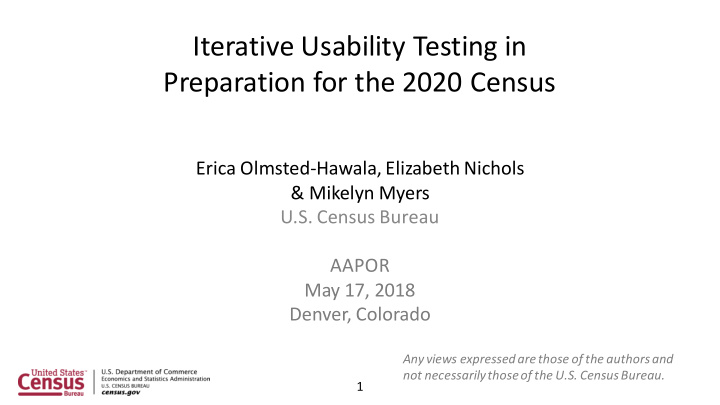



Iterative Usability Testing in Preparation for the 2020 Census Erica Olmsted-Hawala, Elizabeth Nichols & Mikelyn Myers U.S. Census Bureau AAPOR May 17, 2018 Denver, Colorado Any views expressed are those of the authors and not necessarily those of the U.S. Census Bureau. 1
Usability Testing • Usability testing shows us how users perform tasks – Measures effectiveness, efficiency and user satisfaction while accomplishing tasks (ISO Standard 9241-11: 1998) – Task for usability testing an online survey is to complete the survey – Goal of researcher is to watch what user is doing and see what parts may be confusing or difficult Image source: UX Mastery, uxmastery.com 2
Iterative Usability Testing • A best practice (Nielsen, 1993) – Multiple rounds of testing on same online survey added to schedule – Issues found in first round of testing can be fixed for next round and re-tested in subsequent rounds Test Analyze – Recommended changes can be validated or tweaked based on user feedback • Can occur until questionnaire is deployed Fix (Medlock, Wixon, McGee & Welsh, 2005) 3
Example Iterative testing: 2015 Census Test Same survey with 2 rounds of testing Round 1 of testing Round 2 of testing Use of Users ellipses tried to instead of click on line underline Response More options spacing too close between together response options 4
Usability Testing in a Production Environment • Iterative testing of the survey is the goal – but sometimes… – Survey life-cycle does not allow for iterative testing – Usability team may only gain access to final online instrument weeks before it is released to the public – What kind on an impact can usability have? • No time to make major (or even minor) changes • No time to re-test changes • No time to see what new issues may occur 5
Reoccurring Surveys & Usability Testing • Surveys that run every year • Surveys that run on a periodic basis – – Updated questions – Moving from paper to online or online to mobile • Can do iterative usability testing across field periods as opposed to only before a single field period 6
Iterative Usability Testing: The Long Term Approach • Conduct usability testing across the different field tests – One field test: • Conduct usability testing • Identify user issues & make recommendations • Site goes live “as is” - without user issues being addressed – Next field test: • Modify usability testing protocol updated for new field test • Add in vignettes and debriefing probes (can address issues from prior year’s field test) • Conduct usability testing • Identify user issues & make recommendations – Learn whether issues observed in prior field test persist, or if new issues arise 7
Multi-year Iterative testing Similar survey, across field periods National Content Test 2015 2016 Census Test 8
Long Term Approach Need to remember what the user issues were in last field test **Likely you have had other projects in the interim, and when next field test comes around – do you recall what the issues were? 9
Long Term Approach: Strategies Documentation • – Screenshots of previous versions – High level findings & recommendations Communicate with sponsor & programmer • – Learn whether new design has incorporated issues found in last round of testing – If you continue to have meetings – bring it up. Ask about the status of the changes – Helps to remind team of what was found and what was agreed to at end of last testing cycle Follow up once gaining access to instrument • – As you prepare for the next round of testing (months or even a year later) – check to see what has changed • Were issues addressed? • If not, document and ask to meet with team to discuss • Be persistent 10
Challenges with Multi-Year Usability Projects 11
Challenges • Technology changes – “Specs” give the questions and responses, but nothing on design – Changing survey platforms Keypad is may support different covering “default” settings entry field 12
Challenges • Staff changes – Issues we had identified in Number keypad earlier years come up again should pop open for any response field that requires a number 13
Challenges • Requirements change – Language needs evolve – Security expands 14
Challenges URLs take respondents • to English landing page - language toggle buried & far from primary task Respondents’ browsers • or devices detect English text and offer machine translation instead of our pretested translations 15
Challenges: Multiple Languages • URLs we tested were challenging for respondents with Limited English Proficiency (LEP) • Unfamiliar English words, easy to transpose letters – URL in English: https://survey.census.gov/censustest – URL in Spanish: https://encuesta.censo.gob/pruebadelcenso 16
Challenges: New Security Requirements • Security requirements grow as technology evolves throughout the decade – User interface may not be ideal for the participant – Must be implemented • CAPTCHA (a security procedure to prevent attacks by bots) • Users struggle • Could cause break-offs but we can’t make changes 17
Planning for Alternative Ways to Incorporate Usability into a Production Life Cycle • When all else fails and you cannot get usability testing input prior to when the survey is fielded… – Conduct expert reviews – Run internal staff on “Dry Runs” – Consider usability testing while survey is live in field – Plan for usability testing after survey is fielded (extend the window for the site for a week or two) – Take a long term approach across release cycles and add user feedback when you can 18
Summary • Iterate within and across field periods – Good documentation of what the issues and proposed solutions – Communicate – Follow Up 19
Recommend
More recommend